Space Colonisation Food Package rworldbuilding Biology Diagrams Growing food in space could assist in human colonization By Zhang Lei (China The United States spends between $10,000 and $100,000 to transport every kilogram of food it sends into space, and

The intersection of agriculture and space exploration presents a unique opportunity to address the pressing issue of food security on Earth. As the global population continues to rise, the demand for sustainable food sources becomes increasingly critical. Space farming, the practice of growing crops in extraterrestrial environments, not only holds promise for future space missions

Pros, Cons, Debate, Arguments, Mars, Moon, Human ... Biology Diagrams
This closed-loop approach reduces the need for additional nutrients and promotes sustainability in long-duration space missions and colonization efforts. 4. Fresh Food Supply: Maintaining a fresh food supply is essential for the physical and psychological well-being of astronauts during extended space missions. Hydroponic systems enable For instance, food scarcity is not about the classic rhetoric blaming that there is not enough food to feed the world. This is not true. There has never been so much food production, but how is that food being evenly distributed, is it used to feed people, cattle, or biofuel plants… those are the questions that need to be debated. FOOD WEBS 31 INTRODUCTION "The classic marine food chain -algae, zooplank- ton, fish- can now be considered as a variable phe- nomenon in a sea of microbes (Karl 1999)." The food web is one of the earliest and most fun- damental concepts in ecology. Darwin (1845) recog- nized the existence of a pelagic food chain.

Numerous cinematic portrayals and pop culture references have presented potential scenarios when humans run out of food and water sources on Earth. Most plots depend on the remaining crops on dull As humanity looks to the stars, the need for sustainable food production systems in extraterrestrial environments becomes increasingly critical. This article explores the potential of interstellar agriculture, its implications for food security, and how it could redefine supply chains in a future where space colonization is a reality. Pro 2: Space colonization is the next logical step in space exploration and human growth. Read More. Con 2: Humans have made a mess of Earth. Living on Mars will require mastery of recycling matter and water, producing food from barren and arid soil, generating carbon-free nuclear and solar energy, building advanced batteries and materials
